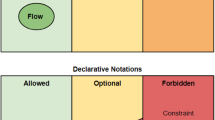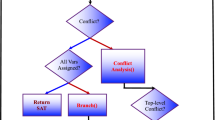Abstract
The model-based diagnostic approach was first introduced to overcome the limitations of heuristic systems. However, research on model-based systems showed that the model-based diagnosis approaches resort to assumptions that can be viewed as the return, though controlled, of heuristics into diagnostic reasoning. In this paper we focus on diagnosis with component-oriented device models. We argue for the need to represent and reason with these assumptions. We present a conditional logic, DL, That is suitable for diagnostic reasoning and allows us to represent and reason with assumptions.
Similar content being viewed by others
References
R. Davis, “Diagnostic reasoning based on structure and behavior,” Artificial Intelligence, vol. 24, pp. 347-410, 1984.
W. Hamscher, “Modeling digital circuits for troubleshooting,” Artificial Intelligence, vol. 51, no. 1-3, pp. 223-271, 1991.
I. Mozetic, “Hierarchical model-based diagnosis,” in Readings in Model-Based Diagnosis, edited by W. Hamsche, L. Console, and De Kleer, Morgan Kaufmann Publishers, Inc., 1992.
C. Boettcher and O. Dressller, “Diagnosis process dynamics: Holding the diagnostic trackhound in leash,” in Proceedings of the International Joint Conference on Artificial Intelligence, Morgan Kaufmann Publishers, 1993.
W. Nejdl, P. Froehlich, and M. Schroeder, “A formal framework for representing diagnosis strategies in model-based diagnosis systems,” in Proceedings of the 14th International Joint Conference on AI (IJCAI-95), Montreal, Canada, Aug. 20-25, 1995.
J. McCarthy, “Circumscription–A form of non-monotonic reasoning,” Artificial Intelligence, vol. 13, pp. 27-39, 1980.
R. Reiter, “A logic for default reasoning,” Artificial Intelligence, vol. 13, pp. 81-132, 1980.
G. Biswas, R. Kapadia, and X. Yu, “Combined qualitative quantitative steady state diagnosis of continuous-valued systems,” IEEE Transactions on Systems, Man, and Cybernetics, vol. 27, no. 2, pp. 167-185, 1997.
G. Biswas, S. Manganaris, and X. Yu, “Extending component connection modeling for analyzing complex physical systems,” IEEE Expert, vol. 8, no. 1, pp. 48-57, 1993.
G. Biswas and X. Yu, “A formal modeling scheme for continuous systems: Focus on diagnosis,” in Proceedings of the International Conference on Artificial Intelligence, 1993, pp. 1474-1479.
C. Boettcher, “No faults in structure? – How to diagnose hidden interactions,” in Proceedings of the Fifth International Conference on Artificial Intelligence, Morgan Kaufmann Publishers, 1996, pp. 1728-1734.
C. Preist and B.Welham, “Modelling bridge faults for diagnosis in electronic circuits,” in Proceedings of the 1st International Workshop on Principles of Diagnosis, Stanford, 1990.
V. Devedzic and D. Velasevic, “Features of second generation expert systems–An extended overview,” Engineering Applications of Artificial Intelligence, vol. 3, no. 4, pp. 255-270, 1990.
T. Hansen, “Diagnosing multiple faults using knowledge about malfunction behavior,” in First International Conference on Industrial Engineering Applications of AI and ES, 1988, vol. 1, pp. 29-36.
T.A. Nguyen, W.A. Perkins, T. Laffey, and D. Pecora, “Knowledge base verification,” AI Magazine, vol. 8, pp. 69-75, 1987.
M.R. Genesereth, “The use of design descriptions in automated diagnosis,” Artificial Intelligence, vol. 24, pp. 411-436, 1984.
M. Schwarzblat and J. Arellano, “An expert diagnostic and prediction system based on minimal cutset techniques,” in Proceedings of the Second Conference on Artificial Intelligence Applications, 1985.
S. Shapiro, S. Srihari, M. Taie, and J. Geller, “VMES: A network based versatile maintenance expert system,” in First International Conference on Applications of Artificial Intelligence in Engineering Problems, 1986.
R. Mathonet, H. Van'Cotthem, and L. Vanryckeghem, “DANTES: An expert system for real-time network troubleshooting,” in Proceedings of the Seventh InternationalWorkshop on Expert Systems & Their Applications, Avignon, 1987, pp. 468-488.
S. Nold, R. Isermann, and B. Freyermuth, “A multilevel knowledge-based concept for the supervision of technical processes,” in Proceedings of the Fifth International Symposium on Technical Diagnostics, 1987, pp. 145-152.
R. Reiter, “A theory of diagnosis from first principles,” Artificial Intelligence, vol. 32, pp. 57-95, 1987.
L. Console, T. Dupre, and P. Torasso, “A theory of diagnosis for incomplete causal models,” in Proceedings of the International Joint Conference on Artificial Intelligence, 1989, pp. 1131-1137.
J. De Kleer and B.Williams, “Diagnosis with behavioral modes,” in Proceedings of the International Conference on Artificial Intelligence, 1989, pp. 1324-1330.
P. Struss and O. Dressler, “Physical negation–Integrating fault models into the general diagnostic engine,” in Proceedings of the International Joint Conference on Artificial Intelligence, 1989, pp. 1318-1323.
L. Console and P. Torasso, “On the co-operation between abductive and temporal reasoning in medical diagnosis,” Artificial Intelligence in Medicine, vol. 3, no. 6, pp. 291-311, 1991.
L. Console and P. Torasso, “A spectrum of logical definitions of model-based diagnosis,” Computational Intelligence, vol. 7, no. 3, pp. 133-141, 1991.
R. Davis and W. Hamscher, “Model-based reasoning: Troubleshooting,” in Exploring Artificial Intelligence, Ch. 8, Morgan Kaufmann Publishers, pp. 197-436, 1992.
W. Hamscher, J. Console, and J. DeKleer (Eds.), “Reading in model-based diagnosis,” Morgan-kaufmann Publishers, CA, USA, 1992.
L. Chittaro, G. Guida, C. Tasso, and E. Toppano, “Functional and teleological knowledge in the multimodeling approach for reasoning about physical systems: A case study in diagnosis,” IEEE Transactions on Systems, Man and Cybernetics, vol. 23, no. 6, pp. 1718-1715, 1993.
J. McCarthy, “Application of circumscription to formalizing commonsense knowledge,” Artificial Intelligence, vol. 28, pp. 89-116, 1986.
K. Clark, “Negation as failure,” in Logic and Databases, edited by H. Gallair and J. Minker, Plenum Press: New York, pp. 293-322, 1987.
D. Lewis, Counterfactuals, Blackwell, Oxford, 1973.
R. Stalnaker, Inquiry, MIT Press: Cambridge, Mass, 1985.
R. Stalnaker, “A theory of conditionals,” in Studies in Logical Theory, (American Philosophical Quarterly, Supplementary Monograph Series), Oxford, 1968, pp. 98-112.
R. Stalnaker and R. Thomason, “A semantic analysis of conditional logic,” Theoria, vol. 36, pp. 23-42, 1970.
S. Kraus, D. Lehmann, and M. Magidor, “Nonmonotonic reasoning, preferential models and cumulative logics,” Artificial Intelligence, vol. 44, pp. 162-207, 1990.
G. Crocco and P. Lamarre, “On the connection between conditional logics and nonmonotonic logics,” in Proceedings of the International Conference on Knowledge Representation and Reasoning (KR'92), edited by Bernhard Nebel, Charles Rich, and William Swartout, Morgan Kaufmann Publishers, 1992, pp. 565-571.
N. Obeid, “On normal default reasoning and conditional logic,” Progress in Artificial Intelligence, edited by H. Coelho, in Proceedings of 6th Iberoamerican Conference on Artificial Intellligence, 1998, pp. 81-92.
L. De Kleer, A.K. Mackworth, and R. Reiter, Characterizing Diagnoses and Systems, Artificial Intelligence, vol. 56, no. 2-3, pp. 197-222, 1992.
R. Benjamins, “Problem-solving methods for diagnosis,” Ph.D. Thesis, University of Amsterdam, Amsterdam, The Netherlands, 1993.
R. Davis and W. Hamscher, “Model-based reasoning: Troubleshooting,” in Exploring AI: Survey Talks from the National Conference on AI, edited by H.E. Shrobe, Morgan Kaufman, San Mateo, CA, 1988.
J. De Kleer, and J. Brown, “A qualitative physics based on confluences,” Artificial Intelligence, vol. 24, pp. 7-83, 1984.
O. Raiman, “The alibi principle,” in Readings in Model-Based Diagnosis, edited by W. Hamscher et al., Morgan Kaufmann Publishers, San Mateo, CA, 1992.
O. Raiman, J. De Kleer,V. Saraswat, and M. Shirley, “Characterizing non-intermittent faults,” in Proceedings of the 9th National Conference on AI (AAAI-91), Anaheim, CA, July 14-19, 1991.
J. Bell, “Pragmatic logics,” in Proceedings of the Workshop on Knowledge Representation and Reasoning (KR'91), Morgan Kaufmann Publishers, 1991, pp. 365-374.
D. Nute, “Conditional logic,” in Handbook of Philosophical Logic, edited by D. Gabbay and F. Gunthner, Kluwer Academic Publishers, vol. II, pp. 387-439, 1984.
D. Gabbay, “Theoretical foundations for non-monotonic reasoning in expert systems,” in Logics and Models of Concurrent Systems, edited by K. Apt, Springer-Verlag, pp. 439-457, 1985.
B. Chellas, “Basic conditional logics,” in Journal of Philosophical Logic, vol. 4, pp. 133-153, 1975.
V. Lifschitz, “Some results on circumscription,” in AAAI Workshop on Nonmonotonic Reasoning, Mohonk, Oct. 17-19, 1984.
Etherington, 1987b.
Etherington, 1987a.
Obeid N, “A proof procedure for normal default theories,” Journal of Applied Intelligence, vol. 6, no. 2, pp. 165-175, 1996.
G.E. Hughes and M.J. Cresswell, A Companion to Modal Logic, Methuen, London, 1984.
P. Struss, “Diagnosis as a process,” in Readings in Model-Based Diagnosis, edited by W. Hamscher, L. Console, and De Kleer, Morgan Kaufmann Publishers, Inc., pp. 408-418, 1992.
P. Struss, “What's in SD? towards a theory of modeling in diagnosis,” in Readings in Model-Based Diagnosis, Morgan Kaufmann Publishers, pp. 419-449, 1992.
Author information
Authors and Affiliations
Rights and permissions
About this article
Cite this article
Obeid, N. Model-Based Diagnosis and Conditional Logic. Applied Intelligence 14, 213–230 (2001). https://doi.org/10.1023/A:1008322227554
Issue Date:
DOI: https://doi.org/10.1023/A:1008322227554




